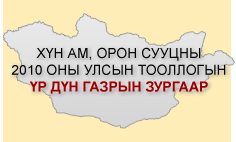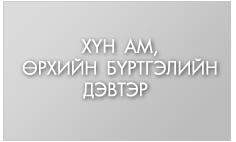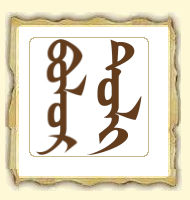| News |
|
Mongolia has launched the main findings of its 2010 Population and Housing Census Mongolia has launched the main findings of its tenth population and housing census which was conducted between 11 and 17 November 2010. As of the reference date, total population of Mongolia is 2 754 685. One of the main features of the 2010 Census was e-enumeration for Mongolians living abroad. According to the main findings, Mongolia has 107 410 citizens living abroad for more than six months, 16 428 foreign citizens and stateless people living for more than six months in Mongolia. The 49.5 percent of the resident population is male, 50.5 percent is female, and the sex ratio is 98.1. Among total, percentage of population aged 0-14 is 27.3, 15-64 is 69.0 percent, 65 and above is 3.7 percent. Dependency ratio in 2010 is 45.0, which has decreased by 19.6 percentage points when compared with 2000. Since the 2000 Population and Housing Census, total population of Mongolia has increased by 381.2 thousands, which is an increase of 16.1 percent. The increase is 0.1 percentage points higher or 51.6 thousand people more than that of between the 1989 and 2000 Censuses. The annual population growth rate is 1.5 percent. Population growth rate, by Census years 
In 2000, average population density of Mongolia was 1.5 persons per square kilometer. In 2010, the density has increased by 0.2 percentage points to 1.7 persons per square kilometer. Population density in the capital city of Ulaanbaatar remains as the highest. In 2000, population density in Ulaanbaatar city was 162 persons per square kilometer; it has increased to 246 persons in 2010.
When looking at religious status of the population, 64.4 percent are with some religious faith, of which 86.2 percent are Buddhist, 4.9 percent are Muslim, 3.5 percent are Christian, 4.7 percent are Shamanist and the remaining 0.6 percent are with other religious faith. Among population aged 15 and above, 31.3 percent are single (never married), 60.1 percent are married, 3.1 percent are divorced or separated and 5.5 percent are widowed. Average age at first marriage for male is 26.2, for female is 24.2, increasing by 0.5 percentage points when compared with 2000. Nationwide, there are 108.1 thousand persons with disability, which represents 4.1 percent of the total population. About 34.0 percent of persons with disability have congenital disabilities, and 66.0 percent have acquired disability. Among population aged 6 and above, 74.0 percent or 1714.6 thousand persons use cellular phones, whereas 30.6 percent or 709.6 thousand persons use internet on regularly basis.
About 45.2 percent of total households live in gers (traditional Mongolian dwellings), 53.7 percent live in different types of houses and buildings and 1.1 percent lives in other types of dwellings. Percentage of households who live in gers has decreased by 5.7 points and those who live in houses has increased by 5.2 points. For urban households, 65.9 percent live in houses and 32.7 percent live in gers that indicate decreased percentage of households who live in houses and increased percentage of those who live in gers when compared with 2000 Census. According to the Census findings, there are 23.2 thousand households without any source of electricity, which is 2.9 times less than that of 2000. About 91.4 percent of households without any source of electricity live in gers of which 81.1 percent are in rural areas. For households who use renewable energy system, 96.7 percent are in rural areas. About 35.0 percent of households who live in gers supply their drinking water from springs, rivers, streams, and lakes. For households who live in houses/ buildings, 40.0 percent of them live in living quarters with size of 21-40 square meters, which was decreased by 14.9 percentage points when compared to previous census period. However, percentage of households who live in living quarters with size of more than 40 square meters has increased 2.9 times that concludes to improved space of living quarters. About 73.1 percent of households who live in houses/ buildings have 1-2 rooms, which has decreased by 7.6 percentage points since 2000. Also, households with central heating system representing 43.8 percent were decreased by 0.6 points since 2000. Households with hot and cold piped water supply system represent 39.7 percent of total households who live in houses/ buildings, which also represent 46.1 percent of urban households and 3.7 percent of rural households. In 2000, percentage of households in houses/ buildings who disposed their solid waste in unauthorized areas represented 10.0 percent; the figure has dropped to 5.2 percent in 2010. About 42.4 percent of households in houses/ buildings have indoor toilet facility, of which 6.1 percent share with others. For more information, please visit www.toollogo2010.mn national statistical office of mongolia, poulation and housing census bureau |
Copyright © Mongolian News. All rights reserved.

 HOME PAGE
HOME PAGE
















